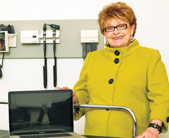Health care at your fingertips
A new web-based tool empowers diabetes patients—and saves health care money

by Peigi McGillivray
Is it possible to improve health care delivery while reducing costs at the same time?
University of Victoria health economist Dr. Angela Downey thinks so. The business professor is currently investigating the service delivery needs and costs associated with the management and treatment of diabetes.
Over the next 10 years, Canada’s changing ethnic makeup, aging population, and increasing obesity and sedentary lifestyles will lead to unprecedented rates of diabetes. And costs associated with diabetes will skyrocket. The Canadian Diabetes Association calls it an impending health care “tsunami.”
Finding new and better ways to manage the coming tidal wave is critical, says Downey. “It’s important for people with diabetes to educate themselves about their condition, to monitor and control it, and to have access to expert advice and guidance. The challenge is to balance those needs with the ever-spiraling costs of health care.”
Downey and colleagues in the UK and at the University of Calgary, the University of Lethbridge and Alberta Health Services are looking to the Internet for solutions. They have developed an interactive, web-based counselling and management tool for people newly diagnosed with type 2 diabetes (the most common adult form).
The site allows patients to connect with health care providers and other patients in the study, post questions, schedule appointments and access extensive educational resources.
To test the effectiveness of the website, three groups were compared: a group who managed their blood hemoglobin through face-to-face meetings with health care providers, a group who used the interactive website, and a group who had access to a static website with information about diabetes but no interactivity.
The team found a significant difference between the three groups. “We were astonished—and heartened—to discover that those who used the interactive website to attend virtual appointments with clinicians had the best results—better even than those meeting face-to-face,” says Downey.
The implications are huge. Interactive websites allow people who live in rural or remote areas and those who are unable to travel to appointments, to receive high-quality services closer to home.
“We know at this point that the initial visit for face-to-face patients lasts for one hour, but that it only takes 45 minutes for interactive patients,” says Downey. “Across the country, that alone is a huge saving for our cash-strapped health system.”
Downey is working with UVic graduate students to help fine-tune the web-based education process.
“Because we were able to collect so much information from the website, we now have a chance to dig deeper,” she says. “My students are analyzing how people learn in an electronic environment and search for information, and about differences between the way men and women use the site.”
This type of intervention could allow people who are newly diagnosed with diabetes or other chronic diseases to get the education they need to manage their conditions, says Downey.
“Right now we’re replicating the diabetes study with the National Health Service in the UK, and are in the planning stages of a similar website to support people with pulmonary disease.
“Better management leads to fewer complications and fewer visits to primary health care providers,” she says. “It should save our health care system millions.”
View as PDF (300K).
- Diabetes is a chronic disease in which the body can’t produce insulin or can’t properly use the insulin it produces. This leads to high levels of glucose in the blood, which can damage organs, blood vessels and nerves.
- According to a Canadian Diabetes Association report, the number of Canadians diagnosed with diabetes will soar from an estimated 2.5 million in 2010 to more than 3.7 million in 2020—almost 10 per cent of the country’s population.
- More than 20 people are diagnosed with diabetes every hour of every day. It is estimated that an additional 700,000 Canadians have the disease but don’t know it.
- The economic burden of diabetes in Canada is expected to exceed $10 billion by 2020. It currently accounts for about 3.5 per cent of public health care spending.
- Downey’s study was funded by the Lawson Foundation Family Trust and the University of Lethbridge.
- Downey’s team included Dr. Helen Kelly from the University of Lethbridge, Dr. Mike Chiasson from Lancaster University in the UK, Dr. Danielle Picaud, an endochronologist from the University of Calgary and Alberta Children’s Hospital, and members of the Building Healthy Lifestyles team at Alberta Health Services in Lethbridge, Alberta.
- UVic researchers were awarded more than $104 million in outside research grants and contracts in 2008/09—more than double the research support of five years ago.
